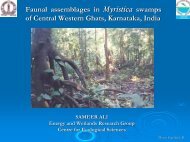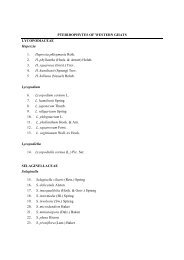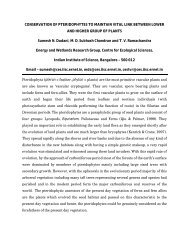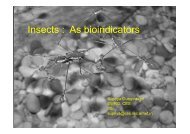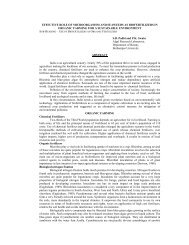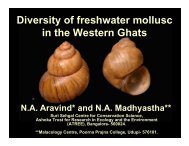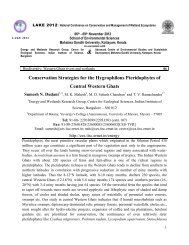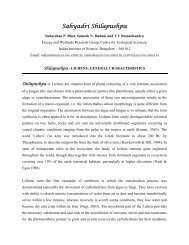The diatom genus Gomphonema Ehrenberg in India: Checklist and ...
The diatom genus Gomphonema Ehrenberg in India: Checklist and ...
The diatom genus Gomphonema Ehrenberg in India: Checklist and ...
You also want an ePaper? Increase the reach of your titles
YUMPU automatically turns print PDFs into web optimized ePapers that Google loves.
Discussion<br />
Our work on the present group of species contributes to a grow<strong>in</strong>g op<strong>in</strong>ion that<br />
endemism <strong>in</strong> freshwater <strong>diatom</strong>s, particularly those based <strong>in</strong> Southern Hemisphere<br />
locations, may be much more common than was previously thought (e.g., Mann &<br />
Droop 1996, Mann 1999, Kociolek & Spauld<strong>in</strong>g 2000, Kociolek & Stoermer 2001,<br />
Kilroy et al. 2003, Vanormel<strong>in</strong>gen et al. 2008). However, recent taxonomic work on<br />
selected <strong>diatom</strong> taxa from Himalayas (Jüttner et al. 2004) <strong>and</strong> the current study has<br />
led to the recognition of an <strong>in</strong>creas<strong>in</strong>g number of endemic taxa <strong>in</strong> the freshwater<br />
<strong>diatom</strong> flora of the <strong>India</strong>n subcont<strong>in</strong>ent, particularly biodiversity hotspots like Western<br />
Ghats <strong>and</strong> Eastern Himalayas. Based on unpublished work by Karthick (Ph.D.<br />
Dissertation on Ecology of Stream Diatom Community <strong>in</strong> Central Western Ghats, to<br />
be submitted to Mysore University), some of the <strong>Gomphonema</strong> species found <strong>in</strong> the<br />
Western Ghats are widespread on other cont<strong>in</strong>ents, but a few others, particularly<br />
those <strong>in</strong> streams of Western Ghats, seem to have limited geographical distributions.<br />
<strong>India</strong> has a diverse flora, but there is still a lot to do to document <strong>and</strong> create a more<br />
substantial underst<strong>and</strong><strong>in</strong>g of this large <strong>and</strong> complex country. <strong>The</strong> three new species<br />
presented here occur <strong>in</strong> several environments, <strong>and</strong> are the dom<strong>in</strong>ants or represent a<br />
large proportion of the <strong>diatom</strong>s present <strong>in</strong> the collections. While there have been<br />
many (over 100) <strong>Gomphonema</strong> taxa reported from <strong>India</strong>, it still does not approach<br />
the number recorded from the <strong>in</strong>tensely studied cont<strong>in</strong>ent of Europe (e.g. Krammer<br />
& Lange-Bertalot 1986, e.g. Reichardt 1999) or the little studied country of the<br />
USA (Kociolek 2005, lists 237 <strong>Gomphonema</strong> taxa reported <strong>in</strong> the literature).<br />
Of the three new species, G. difformum is quite different from almost all other<br />
<strong>Gomphonema</strong> species. Of particular note is the presence of what appears to be apical<br />
pore fields at both the headpole <strong>and</strong> footpole. Our observations illustrate at the<br />
headpole, groups of pores on the mantle at either side of the external distal raphe end<br />
that are separate from <strong>and</strong> quite dissimilar to the areolae. <strong>The</strong>ir oblong to rounded<br />
appearance is more similar to the porelli of the apical pore fields at the footpole than<br />
the slit-like areolae found <strong>in</strong> G. difformum. Structures similar to apical pore fields at<br />
the headpole are also seen <strong>in</strong> G. kaznakowi, described from high mounta<strong>in</strong> sites from<br />
Ch<strong>in</strong>a (Mereschkowsky 1906). Kociolek (1992) showed with electron microscopy<br />
that hyal<strong>in</strong>e areas at the headpole of this species were composed of densely arranged<br />
areolae, that were physically separate from valve face areoale, but not structurally<br />
differentiated from nor more compact (at least <strong>in</strong> terms of the porelli found at the<br />
footpole) than the valve areolae. <strong>Gomphonema</strong> difformum differs from G. kaznakowi<br />
by a number of features, most notably by possess<strong>in</strong>g a stigma <strong>and</strong> hav<strong>in</strong>g external<br />
proximal raphe ends that are quite dilated. <strong>Gomphonema</strong> g<strong>and</strong>hii has a unique feature,<br />
namely the presence of a hood or siliceous fold over the central nodule, the edge of<br />
which is suggestive of the <strong>in</strong>ternal proximal raphe ends. In this feature it looks very<br />
similar to Gomphocymbella species from the East African Rift Valley lakes (Kociolek<br />
& Stoermer 1993); the feature is found <strong>in</strong> no other freshwater gomphonemoid <strong>diatom</strong>s.<br />
<strong>Gomphonema</strong> dim<strong>in</strong>utum seems to be closely allied with species described from the<br />
Himalayas, though more work is necessary to affirm their relationships. For example,<br />
though not described nor illustrated <strong>in</strong> the orig<strong>in</strong>al work, it appears that the Himalayan<br />
species do have both septa <strong>and</strong> pseudosepta. <strong>The</strong>se features have been overlooked by<br />
230



